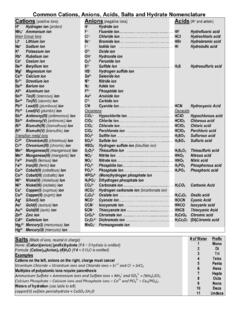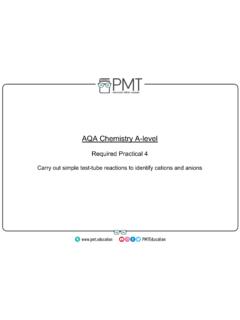Transcription of Analytical Separation of Cations - Weebly
1 Group I Cation Page 39 Chapter 2 Analytical Separation of Cations Analysis for anions (acid radical) and for Cations (basic radical), the two parts of inorganic qualitative: analysis, are carried out separately. Either part may be attacked first. Cations are positively charged fragments or ions of salt or compound. They are frequently referred to as the metals or basic radicals. In studying an unknown, a visual examination should come first. If the unknown is a solution, what color is it ? Color is important because some inorganic ions reveal their identities through color alone. If the unknown is a solid, the color is also important, but it does not necessarily indicate the colors of the individual ions. Thus, Group I Cation Page 40 Pb2+ and I- are both colorless, but they combine to give the bright yellow PbI2.
2 Identification of Cations cannot be performed by tests on the original substances (or salts), therefore .we have to some schemes for the systematic Separation of Cations . Flowcharts are used to represent the steps in qualitative analysis, particularly for the analysis of Cations , which is more systematic than the analysis of anions. A flowchart is a schematic outline that begins with the ions in question, indicated the reagents and the conditions for each step, and gives the formulas for the chemical products that result. In considering qualitative analysis and in carrying out the procedures in the laboratory, keeping track of the Analytical steps is essential. We recommend that you refer to the flowcharts frequently.
3 Flowcharts can be written in various ways, in which precipitates or undissolved solids are carried to the left and ions in solution are carried to the right. Group I Cation Page 41 Cations Common Cations (basic radical) may be divided, for purposes of qualitative analysis, into a number of groups; the members of any group are precipitated by a particular group reagent. Thus by the addition of a slight excess of dilute hydrochloric acid to a solution containing all the common Cations , a precipitate is obtained consisting of the chlorides of silver; lead and mereurous, similarly by the use of the appropriate group reagents, the remaining Cations are separated into different groups. Generally, Analytical Separation of Cations depends on the varying solubilities of their chlorides, sulphides, hydroxides and carbonates.
4 The various groups are summarized in the following table. Group I Cation Page 42 Group Group reagent ions Formula of precipitate Group 1 (silver group) cold, dilute-hydrochloric acid Hg22+ , Pb2+, Ag+ Hg2Cl2, PbCl2, AgCl Group II (Copper and arsenic group) H2S in presence of dilute HCl Hg2+, Pb2+, Bi3+, Cu2+, Cd2+ , Sn2+, Sb3+, As3+ HgS, PbS, Bi2S3, CuS, CdS, SnS, Sb2S3, As2S3 Group III (Iron group) Aq. NH3 in presence of aq. And NH4Cl Al3+, Cr3, Fe3+, Mn3+ Al(OH)3, Cr(OH)3, Fe(OH)3, Mn(OH)3, Group IV (Zinc Group) H2S in presence of aq. And NH4Cl Ni2+, Co2+, Mn2+, Zn2+. NiS, CoS, MnS, ZnS Group V (Calcium Group) (NH4)2CO3 in presence of aq. And NH4Cl Ba2+, Ca2+, Sr2+ BaCO3, SrCO3, CaCO3 Group VI (Alkali Group) No particular reagent Mg2+, K+, Na+, NH4+ Different ppted form Group I Cation Page 43 The steps in Cations analysis fall into the following general sequence: 1- Separation of the Cations into a series of groups The Cations of each successive group are precipitated as compounds with anions supplied by the group reagent.
5 The precipitate (residue) containing the Cations of one group are separated (usually by centrifugation). Then the group reagent for the next group is added to the remaining solution (centrifugate). 2- Separation of the Cations in each group from each other A series of reactions is carried out that eventually leads to the Separation of each cation in a group from all of the others in that group. The reactions are carefully chosen to take advantage of similarities and differences in chemical properties. 3- Identification of individual Cations The presence of cation is confirmed by one or more reactions characteristic of that cation. For ideal Separation of Cations a) The groups should not be too large (3 or 5 members). b) The precipitation of each group should be complete.
6 Group I Cation Page 44 c) The precipitates should be sufficiently insoluble, (filter rapidly and wash well). d) The precipitates should have no tendency to adsorb other ions (or Cations ) from the medium no interference. The insoluble precipitate is formed by the addition of the group reagent . This group reagent is specific for each group of Cations . The active part of these reagents is the anionic part. A typical Analytical scheme for the Separation of the Cations into groups is summarized in the table. Group I Cation Page 45 Group I Cation Page 46 Cation Group I (Silver Group) Mercurous Hg22+ Lead Pb2+ Silver Ag+ Cations Group I bring together three metal ions that form chlorides which are insoluble in acidic solution.
7 The group reagent is cold, dilute-hydrochloric acid, and this group is sometimes known as the hydrochloric acid group, the chloride group, or the silver group. The chlorides of all the other Cations in our cation analysis scheme are soluble in acidic solution. Condition of precipitation (1) Cold hydrochloride acid is used to prevent the solubility of PbCl2 in hot solution. (2) 6M cold hydrochloric acid Use of a moderate excess of hydrochloric acid to precipitate the group serves two purposes: (1) The excess chloride ion "encourages the precipitation of group I (Le Chatelier's principle) the common ion effect of Group I Cation Page 47 the Cl-. : (decrease the solubility of the chloride precipitates of group l) Example: AgCl AgCl Ag + Cl- soluble HCl H+ + Cl- moderate excess common ion effect (2) Also, if the unknown contains Bi3+ or Sb3+ (from the subsequent group) the hydrogen ion prevents the precipitation of them as oxychlorides.
8 Bi3+ + Cl- + H2O BiOCl + 2H+ Sb3+ + Cl- + H2O SbOCl + 2H+ HCl Cl- + H+ Moderate excess common ion effect Solubility of BiOCl or SbOCl if these Cations are present with group I- Cations (Bi3+ ,Sb3+) by the common ion effect of the H+. Group I Cation Page 48 Too large excess of the acid is avoided: (1) Dissolves the silver and lead chlorides by complex formation. Mercury (I) chloride does not dissolve because the chloro complexes of mercury (I) are very unstable. Example: AgCl + Cl- [AgCl2]- Large excess Silver dichloride soluble complex PbCl2 + Cl- [PbCl3]- or [PbCl4]2- Large excess Lead trichloride Lead tetrachloride Soluble complexes (2) Also, if the unknown contains Cd2+ and Sn4+ (from the subsequent groups), the high chloride concentration forms stable soluble complexes with them and inhibits the precipitation of CdS and SnS2 by H2S/H+.
9 Cd2+ + Cl- [CdCl4]2- or Sn4+ + Cl- [SnCl6]2- large excess Group I Cation Page 49 Procedure 1 Procedure 2 Procedure 4 Procedure 3 Separation of Cation Group I Hg22+, Pb2+, Ag+ Cold 6 M HCl Residue Centrifuge Hg2Cl2, PbCl2, AgCl All white ppt (if only cation of group I present discard, otherwise save for cation of group II) H2O, Boil Residue Centrifuge Hg2Cl2, AgCl PbCl2 Conc. NH4OH Divided into 3 portion Residue Centrifuge HgNH2Cl + Hgo White Black white black [Ag(NH3)2]Cl silver diammine H2SO4 PbSO4, white Cool PbCl2 white K2 CrO4 PbCrO4 yellow Dissolve in aqua regia, evaporate 1.
10 SnCl2 2. KI HNO3 until acidic AgCl white Hg22+ present Ag+ present Pb2+ present Group I Cation Page 50 Procedure 1: The solubility products of the precipitates of group l Cations are: PbCl , Ksp X 10-5 AgCl, Ksp X l0-10 Hg2Cl2 Ksp x 10-18 Solubility product constants indicate that lead (ll) chloride is much more soluble than the chlorides of mercury (I) or silver (I). Because the solubility in water of PbCl2 increases from about mol/L at 20 C to about mol/L at 100 C, cold solutions are used in this procedure to maximize precipitation of the lead(II) ion. Addition of excess hydrochloric acid initially reduces the solubility of each chloride by the common ion effect, but a large excess then increases the solubilities of AgCl and PbCl2 as a consequence of the formation of chloro complex ions.








